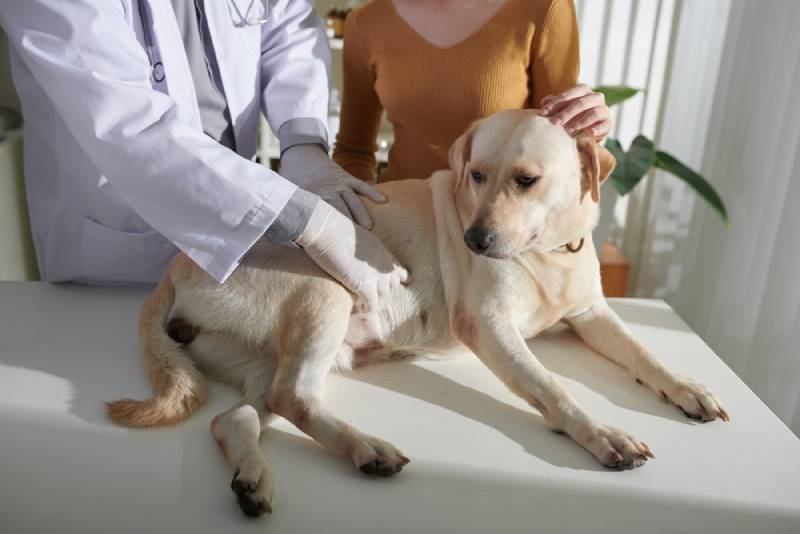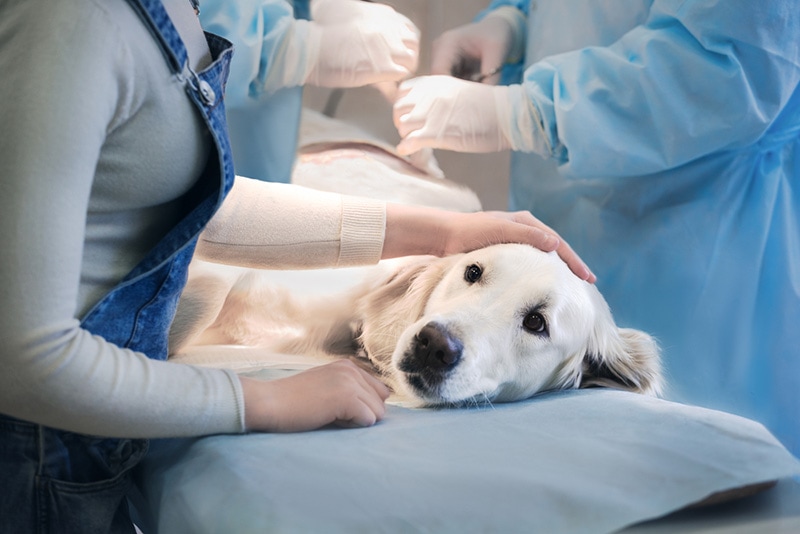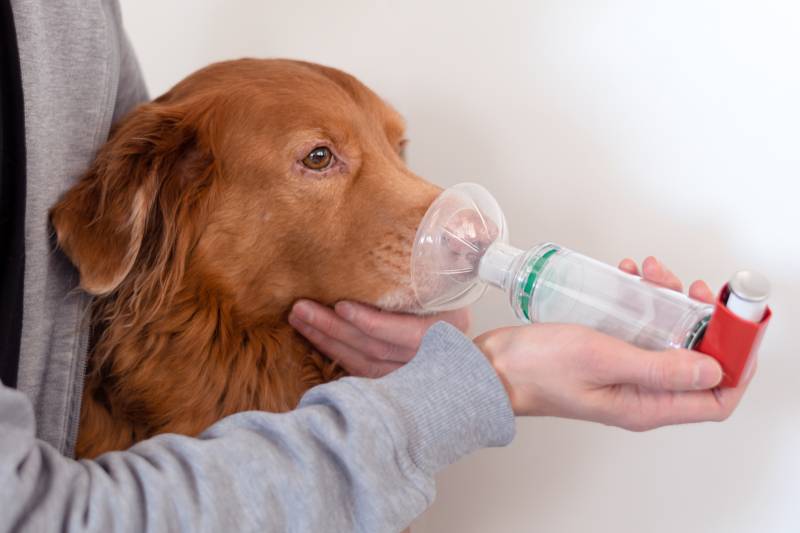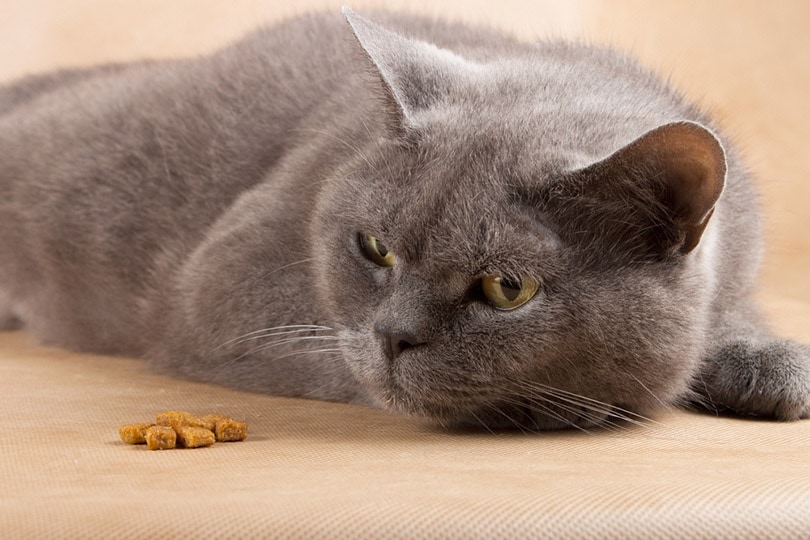My Dog Ate a ChapStick: Here’s What to Do (Our Vet Answers)

Updated on

Imagine you come home to find a chewed ChapStick lid but no tube of lip balm to be found. Or an empty chewed Vaseline pot. Or perhaps you catch your canine friend swallowing your lip balm. So, what do you do?
Is ChapStick Dangerous to Dogs?
There is no short answer here, as there are such a huge number of different types of lip balm and on the market. Unfortunately, most ChapSticks and lip balms are very appealing to dogs, especially if they’re flavored! There are two main concerns when your dog eats a ChapStick. One is the plastic or tin container that the lip balm comes in. The other is that ingredients in the lip balm can cause problems for your dog.
If your dog eats the whole tube lip balm, then there is a risk that the packaging could get stuck in their stomach or intestines. This is more of a risk with larger packaging (for example Vaseline tins or some of the plastic EOS ChapSticks) or if multiple tubes are eaten. When a dog eats an indigestible object, it is known as a “foreign body” and can block their insides, causing serious damage or worse. You can read more about dogs eating plastic here.
There are several ingredients commonly found in ChapSticks that can be dangerous to dogs. Examples include Xylitol, camphor, sunscreen, essential oils, and phenol. Toxicity depends on the amount ingested – and partly on your pet. Thankfully, in most cases, eating a tiny amount of these ingredients from a ChapStick won’t cause any problems. However, age, liver function, and kidney health can all influence the severity of a reaction. Plus, some dogs just react badly to tiny amounts whereas others don’t react at all!
Petroleum (found in Vaseline) is usually relatively harmless. However, beware of other ingredients in the flavored varieties. You should always seek advice from your veterinarian or the Pet Poison Helpline if your dog has eaten something they shouldn’t have, regardless of the amount eaten.
What Will Happen if My Dog Eats a ChapStick?
If your dog has eaten a whole container of lip balm, they may show signs relating to a foreign body. These include sickness (with or without blood), loss of appetite, lethargy, and either diarrhea or lack of stools.
The most common symptoms of swallowed poisons are sickness, diarrhea, agitation, and heart problems. Symptoms would vary depending on the ingredients. We’ll go through some of the common ingredients here:
- Xylitol: This commonly used sweetener causes low blood sugar in dogs and, if enough is eaten, can cause liver failure. Typically, symptoms start very quickly after eating. These include vomiting, drowsiness, weakness, collapse, and seizures. You should call your vet immediately if your chosen brand of ChapStick contains xylitol.
- Essential oils: Commonly used essential oils include peppermint and tea tree. These can cause drooling, sickness, sleepiness, and difficulty breathing, although usually only if taken in higher amounts.
- Sunscreen: ChapSticks often contain added sunscreen, great for your lips but not for your furry friend! In small quantities it doesn’t normally cause a problem but can lead to diarrhea and bloody vomit.
- Phenol: This compound tends to cause local irritation, with drooling and reluctance to eat most commonly seen.
- Camphor (for example in Carmex): Can lead to your dog being sick, feeling nauseated, having diarrhea, and being lethargic.
My Dog Ate ChapStick, What Do I Do?
1. First, don’t panic and stay calm!
It’s likely that your dog will be ok, but a bit of sleuthing and advice from the vet is best to be on the safe side.
2. Collect what remains of your ChapStick or lip balm, if anything.
You’ll need to work out which brand was eaten and the ingredients. You’ll also need to know how much your dog has eaten.
3. Call your veterinary clinic for advice.
Have the details of the brand of ChapStick to hand, with the ingredients list if you have it. Explain how much your dog has eaten, when, and let them know the size and most recent weight of your dog. If your clinic is not open, call the nearest open veterinary clinic, or the Pet Poison Helpline.
What Will Happen if a Dog Eats ChapStick?
What happens from here will depend on what exactly your dog has eaten and whether he or she is showing any signs of being unwell. You may be asked to monitor your dog at home, in which case you’ll need to be watching for sickness, diarrhea, unusual sleepiness, and anything out of the ordinary. If you have any concerns that you’re seeing these symptoms, you should contact your veterinary clinic straight away.

Your veterinarian may offer to give your dog an injection to make them sick to bring up what they have eaten. Whether this is an option will depend on when your dog ate the offending object, how toxic the ingredients are, and whether the packaging could have any sharp edges.
Warning! If Your Dog Ate ChapStick, Do Not Force Them to Vomit at Home
You should never try to make your dog vomit at home without seeking veterinary advice. Inducing vomiting in dogs is not a risk-free process – the object could get stuck on the way back up, or the ingredients could burn the nose and throat. Dogs can also inhale their vomit, which can be a serious, life-threatening issue for some types of toxin. Trust your vet to weigh the risks of making your dog vomit and advise you accordingly.
Possible Testing Scenarios
Your veterinarian may also want to take a blood sample to assess for any internal damage, or to check blood glucose levels. They may give you medications to protect the stomach, medications to help absorb any remaining toxins, or anti-sickness drugs. In some cases, it may be necessary for your dog to stay in the clinic for a drip.
If your dog has eaten the plastic or metal packaging of the ChapStick, they may need X-rays to look at where the packaging is and to see if your dog has a blockage. Not all materials show up on an X-ray. If there’s no obvious blockage, it’s likely that your veterinarian will monitor your dog to try to allow small pieces of plastic to pass on their own. However, larger or sharp pieces of plastic or metal tins may need to be removed by an operation.
Can Dogs Die From Eating ChapStick?
It’s unlikely that dogs would die from eating ChapStick, as most ChapSticks are small enough that any toxic ingredients shouldn’t cause too much of a problem. However, it’s not impossible that your dog could get ill or die from eating a ChapStick, so prompt assessment and treatment by a vet is key. As always, prevention is better than cure, so try to keep any yummy-smelling toiletries out of reach of those curious mouths!
Related Reads:
- My Dog Ate Corn Cobs! Here’s What to Do (Vet Answer)
- My Dog Ate Rat Poison! Here’s What to Do (Vet Answer)
Featured Image Credit: Dragon Images, Shutterstock












